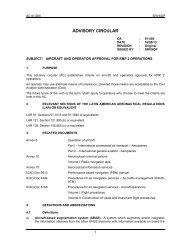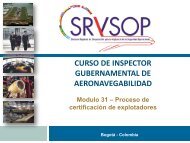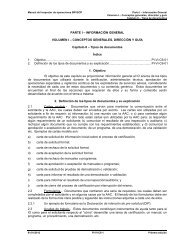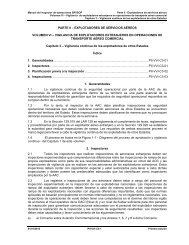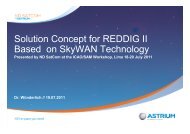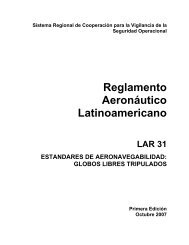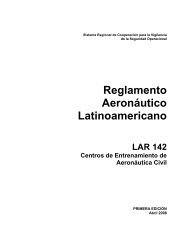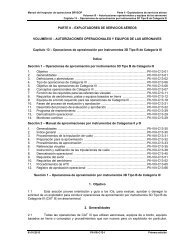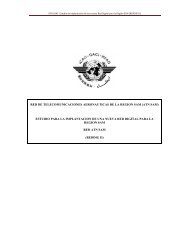CA 91-008 RNP APCH - ICAO
CA 91-008 RNP APCH - ICAO
CA 91-008 RNP APCH - ICAO
You also want an ePaper? Increase the reach of your titles
YUMPU automatically turns print PDFs into web optimized ePapers that Google loves.
SRVSOP AC <strong>91</strong>-<strong>008</strong><br />
6.4 Air traffic service (ATS) communication and surveillance<br />
a) <strong>RNP</strong> <strong>APCH</strong> operations do not include specific requirements for communication and ATS surveillance.<br />
Adequate obstacle clearance is achieved through aircraft performance and operating procedures.<br />
Where reliance is placed on the use of radar to assist contingency procedures, it must be<br />
demonstrated that its performance is adequate for this purpose. The radar service requirement will be<br />
identified in the AIP.<br />
b) Appropriate radio phraseology will be published for <strong>RNP</strong> <strong>APCH</strong> operations.<br />
c) It is expected that Air traffic control (ATC) to be familiar with aircraft VNAV capabilities, as well as with<br />
aspects concerning altimetry setting and the effect of temperature that could potentially affect the<br />
integrity of baro-VNAV <strong>RNP</strong> <strong>APCH</strong> operations.<br />
d) The particular hazards of a terminal and approach area and the impact of contingency procedures<br />
following a multiple loss of <strong>RNP</strong> <strong>APCH</strong> capability must be assessed.<br />
6.5 Navigation accuracies associated with the flight phases of a <strong>RNP</strong> <strong>APCH</strong> approach<br />
a) According to I<strong>CA</strong>O Doc 9613, navigation accuracies associated with the flight phases of a <strong>RNP</strong><br />
<strong>APCH</strong> approach are the following:<br />
1) initial segment: <strong>RNP</strong> 1.0<br />
2) middle segment: <strong>RNP</strong> 1.0<br />
3) final segment: <strong>RNP</strong> 0.3<br />
4) missed approach segment: <strong>RNP</strong> 1.0<br />
6.6 Additional considerations<br />
a) It will be consider that many aircraft have the capability to execute a holding pattern manoeuvre using<br />
an <strong>RNP</strong> system.<br />
7. DESCRIPTION OF THE NAVIGATION SYSTEM<br />
a) Lateral navigation (LNAV).- In LNAV, the <strong>RNP</strong> equipment enables the aircraft to be navigated in<br />
accordance with appropriate routing instructions along a path defined by WTP held in an on-board<br />
navigation database.<br />
Note.- LNAV is typically a flight guidance systems mode, where the <strong>RNP</strong> equipment provides path steering commands to the<br />
flight guidance system, which then controls flight technical error (FTE) through either manual pilot control with a path deviation<br />
display or through coupling to the FD or AP.<br />
8. AIRWORTHINESS AND OPERATIONAL APPROVAL<br />
8.1 In order to get an <strong>RNP</strong> <strong>APCH</strong> authorization, a commercial air transport operator shall obtain two<br />
types of approval:<br />
a) an airworthiness approval from the State of registry; (see Article 31 of the Chicago Convention and<br />
paragraphs 5.2.3 and 8.1.1 of Annex 6, Part I); and<br />
b) an operational approval from the State of the Operator (see paragraph 4.2.1 and Attachment F to<br />
Annex 6, Part I).<br />
8.2 For general aviation operators, the State of registry will determine if the aircraft meets the<br />
applicable <strong>RNP</strong> <strong>APCH</strong> requirements and will issue the operational authorisation (e.g., a letter of<br />
authorization – LOA) (see paragraph 2.5.2.2 of Annex 6, Part II).<br />
8.3 Before submitting the application, operators shall review all the aircraft qualification<br />
requirements. Compliance with airworthiness requirements or the installation of the equipment, by<br />
themselves do not constitute operational approval.<br />
8



